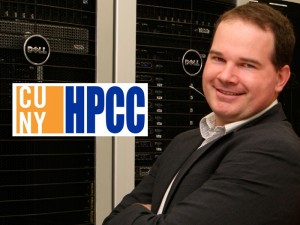
CSI's Dr. Dan McCloskey recently received an $800,000 NSF CAREER grant for his proposed work on animal social behavior.
Dr. Dan McCloskey of the College of Staten Island’s Department of Psychology was recently awarded an $800,000 National Science Foundation (NSF) Faculty Early Career Development (CAREER) grant for his proposed work on animal social behavior.
The NSF CAREER grant is the foundation’s most prestigious award in support of junior faculty who exemplify the role of teacher-scholars through outstanding research, excellent education, and the integration of education and research within the context of the mission of their organizations. Dr. McCloskey is an Assistant Professor of Psychology at the College of Staten Island, a senior college of The City University of New York.
Dr. McCloskey’s Career Development Plan proposal focuses on creating a research environment that utilizes computational tools for the collection and analysis of data in two complex systems: animal social behavior and hippocampal neuron activity. Both approaches involve studying a fascinating animal called the naked mole rat, and the grant will help fund the participation of two graduate students and up to four undergraduates on the projects.
Queen of the Naked Mole Rats
Naked mole rats are unique among mammals for a number of reasons including an extremely long life span, an apparent resistance to cancer, and, most importantly, their cooperative breeding system. They are one of only two species of mammals who have a queen who is solely responsible for breeding the entire colony.
The reason that the last point is so important is because since worker naked mole rats do not reproduce, everything they do is for the betterment of the group. They seem to have no selfish motives.
“The naked mole rat hierarchy is very unique,” said McCloskey. “They act more like ants or bees than other mammals, although many human social networks may operate in a similar way.” Studying the mole rats may help researchers to one day understand why humans act the way they do; if there is such a thing as altruism or if every action has a motive behind it.
Social Behaviors Tracked by Super Computer
The researchers insert tiny trackers into the mole rats and, with the help of the equipment and staff at the CUNY Interdisciplinary High-Performance Computing Center (IHPCC) at CSI, track their movements and interactions and compare siblings with different levels of social behavior.
The IHPCC allows McCloskey to track the behavior of each of more than 100 animals in his colony with high resolution as they navigate their way through a complex system of tubes and cages. Each time an animal passes through a tube with a sensor, the identity, location, and time of that event are stored in a database that receives hundreds of thousands events each day.
Algorithmic software written by CSI Vice President for Technology Systems Dr. Michael Kress and Dr. Susan Imberman of the Computer Science Department creates a history for each animal. The history includes where the animal was, what other animals it was with, and whether it was carrying food, nest material, or a newborn to help other animals in the colony.
Networked Science
The next step of the proposal, which will also make great use of the IHPCC, is to then study the naked mole rats at the level of the neuron.
“We will be working with what is called big data,” said Dr. McCloskey when discussing the IHPCC’s ability to process millions of pieces of data. “One file at the neuronal level can fill up gigs of storage within a minute.”
McCloskey’s “network science” approach will involve graphing each animal/neuron and literally drawing lines between interacting animals/neurons using advanced algorithms to shape the graph. In order to weed out coincidences, the researchers will take samples from millions of events. McCloskey’s team eventually hopes to better understand how interactions between neurons coordinate the animal’s interactions with each other.
Discovery Institute Students Benefit
The NSF CAREER grant will provide funding to recruit two graduate students and up to four undergraduate students for the projects that he will help coordinate with the Discovery Institute. McCloskey, who has been involved with the Discovery Institute for more than two years, believes that taking part of this research will help younger students “understand the bigger picture.” To demonstrate his dedication to the Institute and its students, McCloskey has proposed to set up a Twitter account for each naked mole rat so the students can track their progress in real time, using a computer or a cell phone.
When asked why he was so interested in studying animal social behavior, McCloskey responded that understanding how social networks are formed and modified by experience can help to improve situations where those behaviors are impaired, such as in autism and schizophrenia.
McCloskey acknowledges the importance of his social network, which includes colleagues such as Bruce Goldman of the University of Connecticut and Xiowen Zhang of the Computer Science Department. He also gives VP Kress and the IHPCC much of the credit. “Without his involvement and that of the IHPCC, this type of study would not have been possible,” he said, commenting on the sheer amount of data that is being tracked in real time. “We know what a single brain can do, the next frontier is understanding how multiple brains work together,” McCloskey said. “Besides,” he concluded, “It’s really cool to watch them in action.”
BACKGROUND BIO:
Dan McCloskey is an Assistant Professor of Psychology at the College of Staten Island, a seniorcollege of The City University of New York (CUNY) where he is a member of the Master’s program in Developmental Neuroscience. He holds Doctoral appointments at the CUNY Graduate Center in Neuroscience and Neuropsychology. Dr. McCloskey received his PhD in Biological Psychology from The State University of New York at Stony Brook in 2003. He uses a combination of computationally intensive approaches to study animal behavior, quantitative neuroanatomy, and single-cell and network-level electrophysiology. He has co-authored dozens of peer-reviewed journal articles using these techniques to address issues in epilepsy and autism.

![[video] NSF Awards CAREER Grant for Study of How Multiple Brains Work Together](https://csitoday.com/wp-content/uploads/2012/03/dan_mccloskey_career_grant_031312.jpg)










